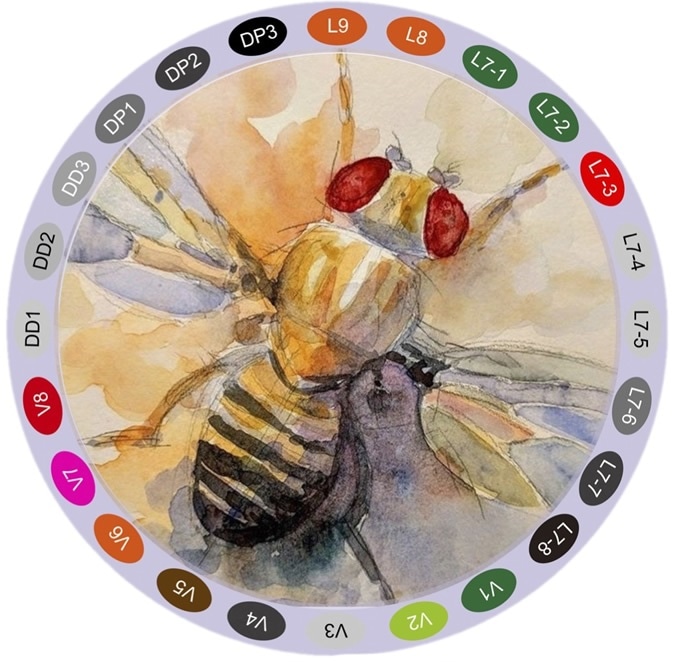Researchers from the University of California, Riverside used a common fruit fly (Drosophila melanogaster) to find the association between taste neurons and control of feeding behaviours. They noted that if they genetically modulated these flies, they could make them selectively avoid certain chemicals including acids, bitter compounds, salty substances etc. The results of their study appeared in the October issue of the journal Cell Reports.

Anupama Dahanukar, David Chen (center), and Ryan Matthew Joseph of UC Riverside. Image Credit: Dahanukar lab, UC Riverside.
Lead author Anupama Dahanukar, an associate professor in the Department of Molecular, Cell, and Systems Biology at UC Riverside, in a statement said, “This work extends our understanding of the function of internal taste neurons present in organs in the pharynx toward ensuring that unpalatable foods are not consumed.” She added, “An understanding of how feeding behavior is controlled in insects may provide insights into developing strategies for controlling insect pests and disease vectors.”
The team explained the fruit flies have their taste neurons on different parts of their bodies and their external taste neurons are present on their legs, wing margins and labellum. Their internal taste neurons are found in the pharynx. These external neurons are responsible for sensing different chemicals explained Dahanukar. She added, “Because of their internal location, pharyngeal organs have not been the focus of many insect studies. But precisely because of their location, they are likely to be critical for controlling food intake.”
Speaking about their study which is a continuation of their previous work, Dahanukar explained, “What's interesting about our findings is that pharyngeal taste neurons have broad functionality for avoiding ingestion of different categories of chemicals, avoidance can be achieved by more than one type of neuron, and activation of just a single pharyngeal neuron can suppress food intake.”
In order to prove the specific aversions created against specific foods and chemicals, the team genetically modified the fruit flies. They selected certain genes to manipulate the pharyngeal taste neurons. Yu-Chieh David Chen, a former graduate student in Dahanukar's lab and the first author of the study said, “We found that rejection of different categories of aversive compounds is dependent on distinct combinations of pharyngeal taste neurons.” Chen is also a Howard Hughes Medical Institute International Student Research Fellow and soon to be postdoctoral researcher at New York University.

Image Credit: Cell Press
The team then traced back the neuronal pathways from the taste neurons to the brain using a technique called the “trans-Tango”. They explained that these taste related sensory neurons are the primary neurons and they are connected with second order neurons which process the taste information for the brain to register. Chen said, “Our mapping results reveal that second-order taste neurons processing sweet and bitter tastes project to two main brain regions.”
Chen added, “In many cases, single pharyngeal taste neurons showed connections with multiple second-order neurons that projected to both brain regions, suggesting that even specific taste information may be broadly conveyed across several brain regions.” This, connection he said was the basis of feeding behaviour as well. He said, “We expect our study will lead to a greater understanding of how taste information is coded in the brain and lay the foundation for system wide analyses of relationships between sensory input and behavioral output.”
Dahanukar also said that this could be the basis of feeding behaviour in almost all animals including humans. This, she explained could be a basis for how feeding behaviours – rejecting or choosing certain foods could affect survival and evolution. She said, “Now that we have some understanding of their organization and function in a genetic model insect, we can apply it to studying pharyngeal organs and how they control feeding in insects that are more relevant from a health or economic perspective, such as mosquitoes and crop-damaging pests. After all, an insect's feeding behavior is pertinent to how much damage it causes.”
The study author team also included Ryan Matthew Joseph of UC Riverside, Scarlet Jinhong Park and William W. Ja of the Scripps Research Institute in Florida. This study was funded by National Institutes of Health and UC Agricultural Experiment Station Mission Funding Program.
Recent related studies by the same team
Chen and Dahanukar also published a similar study in the journal Cellular and Molecular Life Sciences (CMLS) titled, “Recent advances in the genetic basis of taste detection in Drosophila. The study was released this month (October 2019). This was an article where they reviewed available evidence on this matter.
In this study the team wrote that Drosophila melanogaster or fruit flies are a good genetic model for studying various chemical signals and feeding behaviours. They wrote that there are 5 tastants or taste modalities, “sweet, bitter, acid, salt, and amino acid.” Other chemicals that are perceived by the sense of taste include, “fatty acids, carbonated water, polyamines, H2O2, bacterial lipopolysaccharide (LPS), ammonia, and calcium.”
This was a review article where they explained that the “molecular and cellular basis of taste detection” and its effect on taste perception in the fruit fly brain. The team wrote that this review and their previous work would help them understand “how insect behavior is regulated by the gustatory system, which may inform development of novel insect pest control strategies.”
Chen and Dahanukar in December 2017 also came up with another similar study. They focussed on genetically manipulating the taste neurons of fruit flies and speculate that the same could be done for mosquitoes and prevent them from feeding on human blood and spreading diseases such as malaria, dengue, yellow fever, Zika etc. The study was published in December 2017 in the journal Cell Reports.
Dahanukar and Chen had then successfully created transgenic flies with modified pharyngeal neurons. They also fluroscent tagged the neurons to see how the messages from the taste neurons travelled to the brain.
Dahanukar had said about the study, “Using transgenic flies, we were able to examine the expression of fluorescent proteins designed to reflect patterns of chemosensory receptors in pharyngeal taste neurons in the fly and draw a precise molecular map of these organs, which has not been done before.” She added, “We were also able to manipulate selected groups of these neurons to figure out whether they inform the fly to eat certain foods or to avoid them.” Chen said, “The genetic toolkit we have defined can allow us to manipulate selected classes of pharyngeal taste neurons and examine consequences of these manipulations of various functions.”
The authors mated two transgenic flies with one having GAL4 transgene and another having a UAS-GFP transgene. In the offspring flies they could trace the neuronal pathway because it was fluroscence labelled, the team explained. UAS-GFP transgene here allows a green fluorescence protein and to achieve this it needs the GAL4 gene.
Their study provided understanding of the flies’ feeding behaviour as well and they speculated that this could help in pest control in future by genetically altering the insect vectors and their feeding habits.